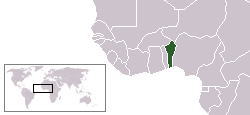|
Where is
Benin?
When I heard that our daughter Satoe was getting sent to Benin,
West Africa, I had no idea where it was. So my husband and I picked up an Atlas and looked for the country. It is
a long , narrow country, the southern tip of which lies on the Gulf of
Guinea. To the west is Nigeria and to the east is Togo.
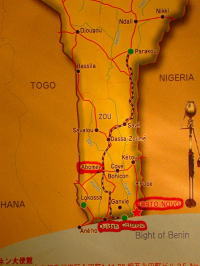 |
|
The map of Benin
Both Cotonou and Porto-Novo are near the sea, Bight of Benin
|
She became a member of JOCV-Japan Overseas Cooperation Volunteers- in
2005.
This is called “ Seinen Kaigai Kyoryokutai” in Japan. JOCV is like the Peace Corps in the USA. I learned that the Peace Corps was founded after the speech of President Kennedy in 1961. In 1965, four years later Japan began to send young people abroad, mainly to Asia.
One
of the people of merit who started Kyoryokutai in Japan is Mr Ichiro Suetsugu,
born in Saga ken.
If you want to know more about JOCV please see <http//www.jica.go.jp>
Before going to various countries, the members have to get about 70days training; Benin was a colony of France, so the language spoken there is mainly French. Satoe had to study it very hard. She left for Benin in July 2005.
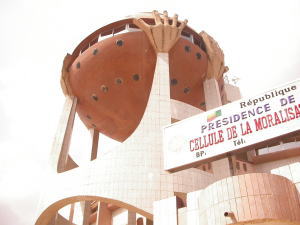 |
|
The vessel with many holes held by hands, was seen in various places.
|
Twenty years ago, parents started visiting the countries where their
sons and daughters work, and every year about 200 people go abroad to see
how they get along. And this is why my husband and I decided to go to Africa.
We left home at 8 a.m., took the high way bus for Shinjuku. At Tokyo City
Air Terminal, all the families going to West Africa, Senegal, Benin, and
Burkina Faso, gathered together and studied about the countries we were going to visit. We left Narita Airport for Paris by Air France and arrived at Charles de Gaulle at about four in the morning. As our
plane for Benin left in the afternoon, we chartered a bus and a very short
sightseeing trip in Paris. At two in the afternoon, four of us got on the plane for Cotonou, Benin.
The above left is a map of Benin. Both Cotonou and Porto-Novo are near the sea and Bight
of Benin. The land is very flat except for the northern part of the country. One
of the symbols of Benin is a vessel with many holes held by hands. I think the
holes represent the problems the country has today.
JOCV BENIN OFFICE
We took a taxi and visited the office to say hello to the coordinators who were taking care of the young people from Japan. Mr.Watanabe, who was the first JICA coordinator to come to Benin, said to us, “Please tell to many people in Japan, that in this country, and other
countries too, members of Kyoryokutai are working very well in a difficult environment.”
D’education
Enseignment Secondaire
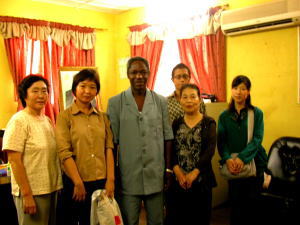 |
| With the Director of Deducation Enseignement Secondaire and the Yamazaki
Family |
After an hour’s drive from Cotonou, we arrived at Porto-Novo, where Satoe
lived. We brought two big suitcases with us . They were filled with Japanese
foods: miso, soysauce, udon, green tea, senbei, nori and so on. We visited the office where she worked , and
got a hearty welcome from the staff there. We have never shaken hands with so many people in our lives. The Director
of DES spoke English, so we could talk with him about our impressions of
this country.
OUIDAH
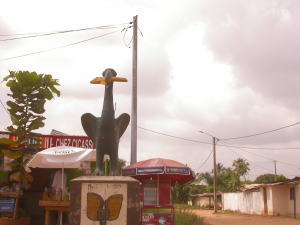 |
| This monument means, from this point they (slaves) never got away like
fish caught by big birds. |
In Ouidah, Europeans built 5 fortresses to centralize the slave trade .One
of them which belonged to Portugal is used as the Museum of Ouidah. I didn’t
know much about the trade of slaves till I visited the museum and read
a book about it. It was sad to know that not only the Europeans but also
the Kings of Abomey made a great profit from the trade of slaves. The kings
needed guns to fight against neighboring countries and the people of Europe
wanted quite a few laborers to work in the new countries they had conquered.
THE GATE OF NO RETURN
On
the coast of Ouidah, there is a gate called ‘the gate of no return’. It was
built by President Soglo in 1994.
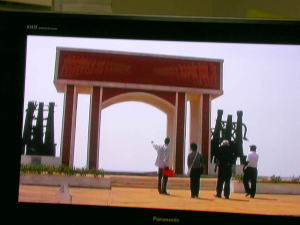
|
| The Gate of No Return |
From the sixteenth century countless slaves went through the gate, hoping
to come back only in spirit, never to return alive. The road leading to the gate is left unpaved, because whenever they see the road covered with red sand, they remember the
blood their ancestors shed..
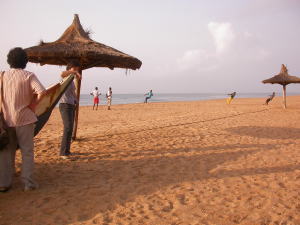 |
| The beach of a resort hotel in Ouidah |
There is a nice resort hotel near the beach. We stayed there for two days. There was no bathtub in our bathroom, but we had a hot water shower for the first time in Benin!
THE BOTANICAL GARDEN
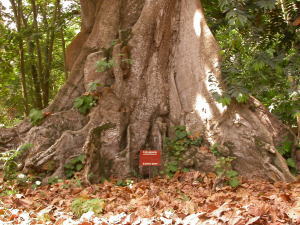 |
| The Botanical Garden in Port-Novo |
In Porto-Novo, we went to a botanical garden.
This is a holy tree. Kings used to rest under it when they were mentally
exhausted . There were a lot of trees we could not see in Japan. A lady
curator explained to us about many plants and herbs used as cures for sickness or injury.
THE VOODOO TEMPLE
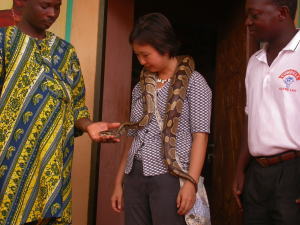 |
| Voodoo temple |
In Benin, Voodoo, Islam, Christianity and
other religions are followed and there are not big problems or conflicts among
them. We visited one of the Voodoo temples. Luckily we were allowed to take pictures. A priest of Voodoo
entered into a dark room and brought a big snake in his hands. The snakes are
worshipped as holy animals in Voodoo. He said to Satoe to put it around her
neck. She said “Yes” without hesitation and let him do it. He said to me, “How
about you?” I answered politely, “ No, thank you”, of course!!
CATHOLIC CHURCH
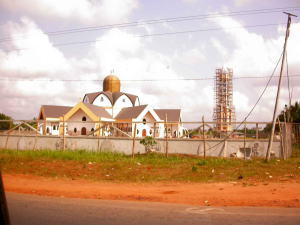 |
| Catholic church |
We
could see some Catholic churches in Benin. This is the church where pilgrims
visiting Dassa Zoume, a sacred place, stop to attend Mass. In DassaZoume, there
is a sacred place where the Holy Mother appeared.
HIGH SCHOOL IN BENIN
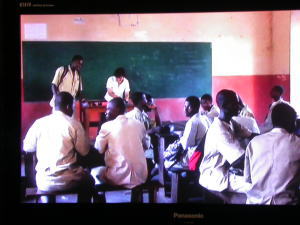 |
| Satoe teaching in her classroom |
Next to her apartment house, there is a boys’ high school, Lycee Behanzin.
She gave extra classes there.It was after six in the evening and we went
to the school to see how she taught the
students.
She was teaching physics in French; I could
not understand neither physics nor French at all.
TAKESHI JAPANESE SCHOOL
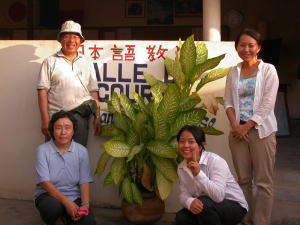 |
| The Japanese school Zomahoun founded |
Zomahoun was born in Dassa Zoume, the northern part of Benin. He appeared on TV in Japan. He published two books. With the royalities from the books and with the help of Takeshi, a famous TV personality and director, he has built three elementary schools in the north, of his country and one Japanese school in Cotonou. We visited the school on the last day in Benin. Two young ladies from Japan welcomed us. They said that their students, ranging from teenagers to sixty-year-olds were eager to learn, and that they enjoyed teaching Japanese very much.
RETURN HOME
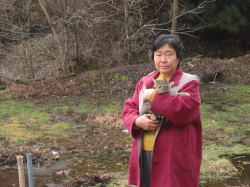 |
| Mitsuko Iijima |
We came back on December 1,safe and sound. But I was very tired and could
not sleep well since then. I was greatly shocked to learn about the gap between the two countries. There was not enough electricity, so in spite of the hot climate, refrigerators and air conditioners were not used in ordinary houses.
But in that country, there are a lot of children! A lot of boys and girls eager
to learn!
In Shimoina-gun, Nagano-ken, where I live, the number of students is so
small that they have to close schools. We have enough clean water to drink
and plenty of food to eat, but when we imagine there are no children, no
young people in our villages and towns, our future is not very hopeful.
|


